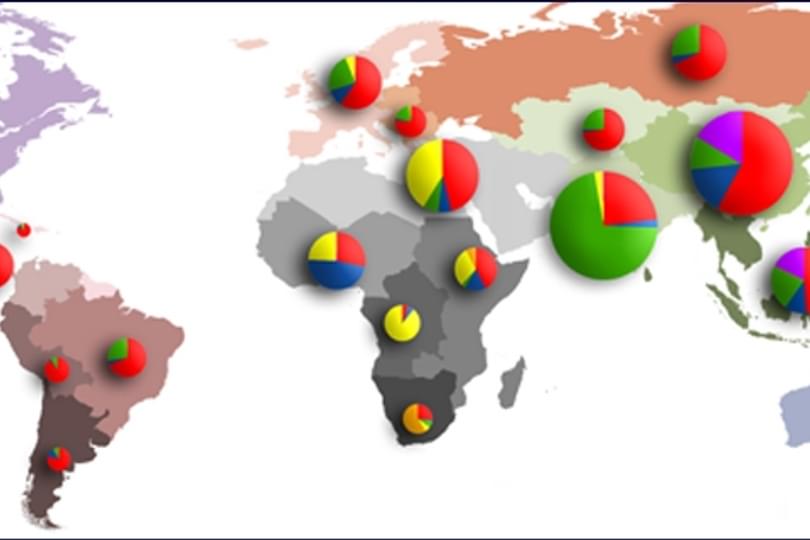
Researchers at the Oxford Martin School have for the first time mapped the global ‘what and where’ of hepatitis C infections, charting the prevalence and geographic distribution of all strains of the virus and creating a crucial resource in the fight to eradicate it.
Worldwide it is estimated that around 185 million people are infected with the hepatitis C virus (HCV). A significant number of those who become infected will go on to develop liver cirrhosis or liver cancer, and up to 500,000 people die each year from liver diseases related to the virus. The good news is that HCV can be cured, and a number of new, dramatically more affordable drug therapies with minimal side effects are set to become available over the next decade. With efforts to create a vaccine also showing promise, the potential to eradicate the disease is now a reality.
But the genetic diversity of the virus - it has six common strains, or genotypes – may be a barrier to further vaccine development and to the deployment of drug therapies. While radically improved treatments will soon be available, and may treat multiple genotypes, the assessment of their efficacy will still need to take specific strains into account. From a cost perspective, it may well be the case that shorter treatment courses are an option in patients with different genotypes. Described in a paper published in Hepatology, a journal of the American Association for the Study of Liver Diseases, the new research from the Oxford Martin School, University of Oxford and Imperial College London equips healthcare decision makers with essential knowledge to execute a successful eradication programme.
By combining studies that are representative of 90 per cent of the global population, the researchers found that while genotype 1 is the most prevalent worldwide, with over 83 million infections, the other genotypes together make up more than half of all hepatitis C cases. In South Asia, genotype 3 is the most prevalent and in parts of Africa and the Middle East the most common genotype is 4.
“This is a very exciting era in the treatment of hepatitis C, with a raft of new drug treatments in development. Our work shows where some genotypes are common and where they’re rarer. It’s extremely important for eradication and vaccine programmes to have access to this information.” Professor Oliver Pybus, of the Oxford Martin School’s Institute for Emerging Infections
“As a world we should be thinking about how we can eradicate this virus. There are new drugs and vaccines in late stage development. But you’ve got to know where the different genotypes are in order to tackle hepatitis C in the most cost-effective way.” Dr Ellie Barnes, Principal Investigator at the Institute for Emerging Infections
The research, which drew on more than 1,200 studies, is now available as an open-access data set.
“Until now it has been incredibly hard to deliver hepatitis C treatment in regions without a good health infrastructure. New hep C treatments make things much easier but we need to be sure we have the right drugs available, and affordable, depending on which strains of the virus are present in each country. The data in this paper shows us the challenge those drugs need to tackle. We can now work out how to make them affordable.” Dr Graham Cooke, Department of Medicine at Imperial College London and a joint senior author of the paper
-
Monday 28 July is World Hepatitis Day 2014 - find out more.
Key facts:
- Persistent HCV infection is associated with liver cirrhosis, hepatocellular cancer, liver failure, and death. It is now the most common cause of death in HIV-positive patients on highly active antiretroviral therapy.
- The distribution of different strains is likely to have been influenced by trends in human population movement across the centuries, for example the transportation of slaves from West Africa to the Americas.
- Historically, HCV treatment has taken the form of interferon and ribavirin therapy by injection over many months. This form of therapy hinders the replication of the virus and enhances the immune response, causing prolonged severe flu-like symptoms in the patient.
- New drug therapies take the form of second-generation DAAs (direct-acting antivirals) taken in pill form, which bind to the machinery of the virus to prevent it from replicating, as with HIV drug therapies. These therapies are associated with cure rates of more than 90 per cent in Phase II or III studies.
- At present, treatment length, cure rates and whether interferon/ribavirin therapy is required alongside DAAs depends on the HCV strain being targeted. A proper assessment of the newest drugs requires a detailed understanding of the viral genotypes within populations.
- Global Distribution and Prevalence of Hepatitis C Virus Genotypes by Jane P. Messina, Isla Humphreys, Abraham Flaxman, Anthony Brown, Graham S. Cooke, Oliver G. Pybus and Eleanor Barnes is published today in Hepatology: http://doi.wiley.com/10.1002/hep.27259